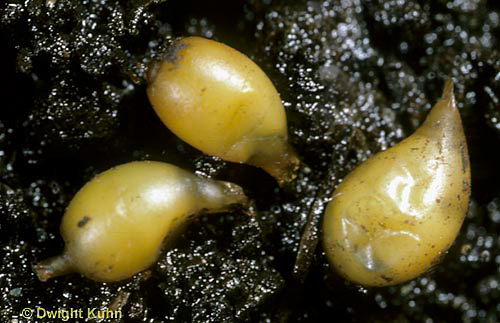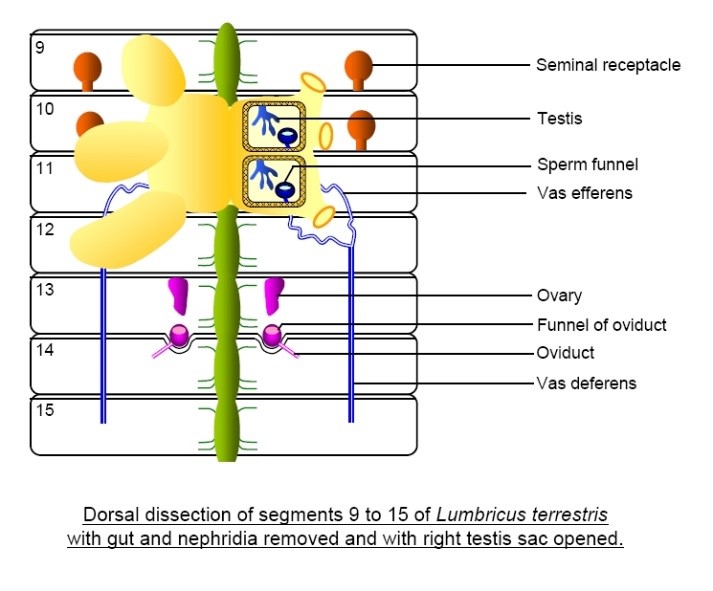Reproduction
As far as reproduction goes for
the species, Lumbricus terrestris, there is more than one method for
reproduction. Most earthworms, including this species, are
hermaphrodites who use cross fertilization as means to sexually
reproduce. However, other times there has been reported
self-fertilization also seen in earthworms (Karaca
2011).
What does it mean to be a cross fertilizing hermaphrodite? According
to J. Díaz Cosín et al., in the book
Biology of Earthworms, 2011, this means the worm is using reciprocal
insemination, which means giving and recieving spermm in the same
mating period. This also means that the species has both male
and female parts. How does the species L. terrestris keep its
reproductive organs separate? The answer can be found back in the
section Form and Function. In essence the worm is segmented and
keeps these parts in different segments. The book
Biology of Earthworms by J. Díaz Cosín
2011, explains the different reproductive organs
found in the earthworm. The female internal organs , are
considered to be the ovaries, oviducts, female pores, and
spermathecae and the male internal reproductive organs, are
the testes and male funnels, seminal
vesicles, deferent ducts.The male parts also include the male pores,
which are slightly less developed then the female pores. The
foremetioned parts were all internal but there are also external organs
involved in the reproduction process. These include, the clitellum,
tubercula pubertatis, and sexual papillae There are also tubercula
and quetae included in the reproductive system of Lumbricus
terrestris. Now that a majority of the reproductive organs were
listed, this website will dive in into what each part does. (Karaca 2011).
First an image is shown to place the reproductive system in persepective.
The first parts discussed, will be
the tubercula and quetae. These external organs attach and
secure different members of Lumbricus terrestris during the
process of cross-fertilization (Karaca
2011).
Now some of the internal reproductive organs will be
explained in detail. First the, clitellum. This organ in the
Lumbricidae family is according to Cosín, though to move
“backwards and seminal groves are developed from the male pores
to the tubercula pubertatis. Spermatozoa flow through the
seminal groves to get into the partner’s spermathecae pores”. So,
it acts as a sperm transfer tube in between to hermaphrodite
partners. Much of the Lumbricade family also contains
spermatophores, which are small clear capsules filled with
Spermatozoa. They are attached to the body wall of the earthworm.
Their function isn't exactly known, but it suggested
they probably are also used in the transfer of sperm, and that
they fertilize ova. (Karaca
2011).

Earthworms are hermaphroditic because it is less costly and
beneficial to the species than self-fertilization, when the
density of earthworms on a geographical area is high. According
to Cosín 2011, The hermaphrodites, due to limited resources,must
trade-off between male and female reproductive functions . Also,
there are benefits and disadvantages to being either. Earthworms
produce their offspring in a cocoon, which can release one or
more offspring each. In general L. terrestris produces
their cocoons in their burrows , so the cocoons can be safe.
In conclusion, the
L. terrestris has options for
reproduction, yet in most cases cross-fertilization is the most
beneficial to the species in an area of high concentration of
earthworms. Earthworms have many sexual organs, both external
and internal, that they organize in their segments. Each organ
has a specified purpose.
Earthworms
have shown many activities in selecting their mate, such as
inspecting their neighbors burrow, skin piercing, control of
produxtion of sperm, and even more. To find out more you could
read the book Biology of Earthworms
edited by Ayten Karaca, 2011.
Earthworms interact with many different organisms in many different ways. To find out more, go to our Interactions page!
Check out where we gathered our information from on our Reference page
Home
